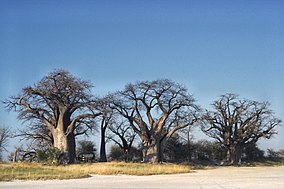Nxai Pan National Park
| Nxai Pan National Park | |
|---|---|
 Baines Baobabs, Nxai Pan National Park, Botswana | |
| Location | Botswana |
| Coordinates | 20°02′30″S 24°46′08″E / 20.0416666667°S 24.7688888889°E |
| Area | 2578 km² |
| Established | 1992 |
Nxai Pan National Park is a national park in north-eastern Botswana, consisting of Nxai Pan, which is one of the Makgadikgadi Pan salt flats. Nxai Pan National Park lies just north of the Maun-Nata main road and adjoins Makgadikgadi Pans National Park on its northern border. The pan itself is a fossil lake bed of approximately 40 km2 in size.[1]
It is home to the cluster of millennia-old baobab trees, which owe their name to Thomas Baines, who first described them for Western botany. Baines’ Baobabs, as they are known today, are a sight sought by many travelers venturing into this untamed terrain of Botswana.[citation needed]
Wildlife
[edit]
Nxai National Park is the habitat of elephant, giraffe, zebra, wildebeest, lion, leopard, cheetah, kudu, springbok, impala, ostrich, Cape wild dog, jackal, hyena, bat-eared fox, aardwolf, and honey badger.
Conservation
[edit]This park is included in the five nation Kavango - Zambezi Transfrontier Conservation Area.[2]
Roads
[edit]The rainy season which is from November to April is the hot wet summer season and the time when the park is at its best. Game is abundant from December to April but if the rains have been heavy the roads may be difficult to negotiate. Road conditions can become difficult during times of heavy rains. The more accessible time to be in the park is in the dry season, which is from May to September.[3]
References
[edit]- ^ "Botswana Travel Guide to Nxai Pan". Siyabona Africa. Retrieved 19 September 2014.
- ^ "KAZA-TFCA". 2013. Archived from the original on 8 May 2013. Retrieved 9 November 2022.
- ^ "Nxai Pan National Park, November 2017". Independent Travellers. independent-travellers.com. Retrieved 30 March 2018.
External links
[edit]
Text is available under the CC BY-SA 4.0 license; additional terms may apply.
Images, videos and audio are available under their respective licenses.
